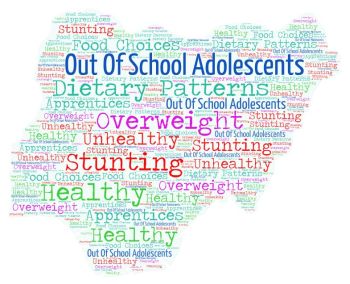Nutritional Status, Dietary Patterns and associated factors among out-of-school Adolescents in Ibadan, Nigeria
Abstract
Background: Studies exploring adolescent dietary patterns (DP) and nutritional status often focus on in-school adolescents with limited data on out-of-school adolescents.
Methods: We sampled 190 out-of-school adolescents on an apprenticeship in Agbowo community, Ibadan, Nigeria. Anthropometric measurements, weight (kg), and height (cm) were taken (to determine the height-for-age and body-mass-index-for-age z-scores) using the WHO AnthroPlus and WHO cut-off points to classify stunting and overweight/obesity. The frequency of food consumption was assessed using an 84-item food frequency questionnaire. The DP was extrapolated using principal component analysis. Bivariate and multivariate logistic regression analyses were used to assess the relationship between sociodemographic variables, anthropometric indices, and DP at P<0.05.
Results: Mean age was 16.9±1.9 years, 61.6% were females and 58.4% had mothers who had at least secondary education. Overall, 12.1% were stunted and 9.5% were overweight/obese. Stunting was significantly more prevalent (P=0.005) among males (20.5%) than females (6.8%). Males had higher odds for stunting [OR: 3.48 (1.39, 8.75) P=0.008], and a lower odds of adhering to a ‘healthy’ DP; [OR: 0.42 (0.22, 0.80), P=0.009]. Also, adolescents with mothers who had at least a secondary school education were less likely to adhere to an ‘unhealthy’ DP [0.26 (0.11, 0.59), P=0.001].
Conclusion: Targeted nutrition education is needed to address unhealthy dietary patterns, particularly among out-of-school adolescent boys.

Authors retain all copyrights. In making a submission to World Nutrition, they are certifying that all material is theirs except quotations, as indicated, and that they have obtained permission for any photos, tables, or graphics taken from other publications or websites.




